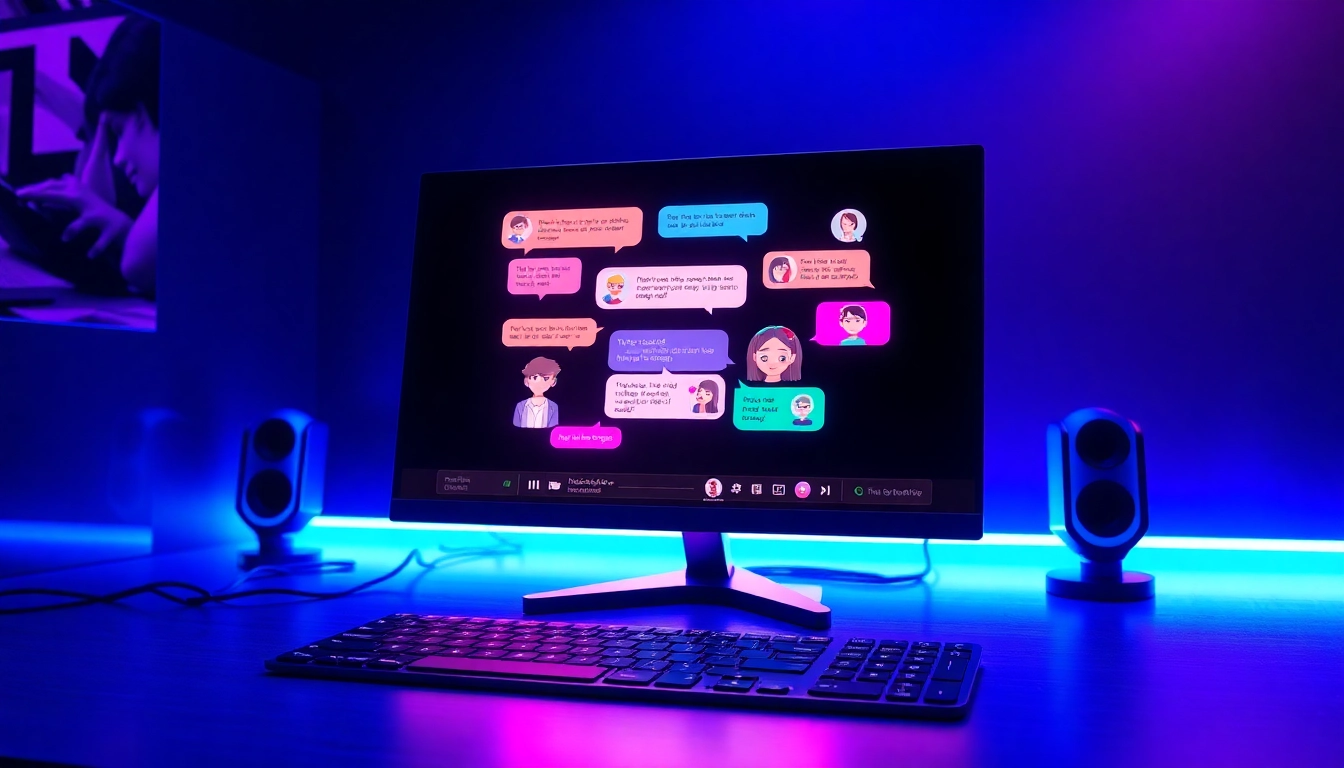Introduction: The Evolution of AI Chat and Visual Storytelling
The landscape of artificial intelligence has undergone a remarkable transformation over the past decade, particularly in the realm of conversational AI. From simple rule-based chatbots to sophisticated models capable of nuanced emotional exchanges, AI chat systems have become integral to digital interaction, entertainment, education, and even personal relationships. If you’re a newcomer eager to understand how to build your own chatbot using platforms like Cursor, you’re stepping into a fascinating field teeming with possibilities.
Today, AI chat isn’t just about answering questions; it’s about creating immersive, emotionally rich, and visually engaging experiences. The convergence of advanced language models and visual storytelling is revolutionizing how we interact with digital characters, making conversations more lifelike, expressive, and impactful. This evolution is driven by innovative platforms such as Crushon, which support unfiltered and dynamic storytelling, including adult content, through a combination of sophisticated artificial intelligence and visual media. As we explore these advancements, you’ll gain insights into how to harness the power of AI to craft your own personalized conversational agents, whether for entertainment, education, or personal projects.
Understanding Modern AI Chat Platforms and Their Capabilities
Modern AI chat platforms have diversified significantly, offering a range of functionalities tailored to different user needs. At the core, these systems leverage large language models such as GPT-4, Claude, or specialized variants like Gork-3 and Ultra Claude 3.5 Sonnet. These models are meticulously fine-tuned to generate highly expressive, context-aware, and emotionally engaging dialogues. Unlike early chatbot versions that relied on predefined scripts, today’s models can produce dynamic, natural-sounding conversations that adapt seamlessly to user inputs.
Platforms like DeepAI, QuillBot, and ChatGPT have popularized AI chat for general use, providing free or subscription-based access to powerful models. These systems are capable of everything from casual chatting and answering complex questions to assisting with coding, creative writing, and even role-playing scenarios. For example, ChatGPT’s ability to hold ongoing conversations, generate stories, and simulate personalities has set a new standard for AI interaction.
However, building your own chatbot using Cursor offers unique advantages: customization, control over conversation flow, and integration with other tools. Cursor’s environment allows you to write code, implement AI APIs, and tailor the chatbot’s personality and behavior precisely to your specifications. Whether you’re aiming to develop a simple question-answer bot or a complex character with emotional depth, understanding the capabilities of these platforms is crucial to designing effective AI interactions.
Crushon: Leading the Way with Unfiltered, Emotion-Rich AI Interactions
Among the emerging platforms, Crushon stands out for its commitment to unfiltered, dynamic storytelling. Unlike many AI services that impose strict content restrictions—particularly on adult or NSFW content—Crushon supports free-form, emotion-rich interactions across all its models. This openness enables users to craft immersive narratives, role-plays, and character interactions that are more authentic and expressive.
Crushon’s suite of over seventeen advanced models, including Claude 3.7 Sonnet, GPT-4o mini, and the recently launched Ultra Claude 3.5 Sonnet, are fine-tuned to produce dramatic dialogue, emotional exchanges, and vivid descriptive storytelling. These models excel at creating characters that can convey complex moods, body language, and contextual nuances, elevating the AI interaction from mere text to a form of digital performance art.
One of the platform’s most innovative features is its ability to integrate visuals into conversations. Through image reply capabilities, users receive context-aware visuals that match the tone of their AI companions—whether playful, romantic, or bold. This feature transforms character AI interactions from solely textual exchanges into rich multimedia experiences, where characters communicate not just through words but also through expressive images that support the unfolding narrative.
The Power of Visuals in Enhancing AI Conversations
Visual storytelling has long been a powerful tool to evoke emotion, provide context, and deepen engagement. In AI chat environments, integrating visuals significantly enhances the immersive quality of interactions. For example, in adult or NSFW scenarios, visuals can depict body language, setting, and mood more vividly than words alone, making roleplay or storytelling more authentic and emotionally resonant.
Crushon’s innovative approach exemplifies this synergy, transforming character AI from static text into dynamic visual narratives. When a character replies with an image, it can convey body language, facial expressions, and even environmental context, enriching the overall experience. This capability is particularly valuable for role-playing, where subtle cues like posture or eye contact add layers of realism and intimacy.
Moreover, visual elements help reduce ambiguity in communication, ensuring that the emotional tone is accurately perceived. For creators and users alike, this means more meaningful interactions, whether in entertainment, personal companionship, or storytelling. The integration of visuals opens new avenues for expressive digital communication, making AI interactions more lifelike and emotionally engaging than ever before.
Advanced Models and Their Role in Expressive Digital Communication
The backbone of expressive AI chat lies in the advanced models designed specifically for emotional and creative outputs. Models like Claude 3.7 Sonnet and Ultra Claude 3.5 Sonnet have been fine-tuned to produce dramatic dialogues, rich descriptions, and emotionally nuanced responses. These models are trained on diverse datasets that include literary, conversational, and emotional content to better emulate human-like expression.
By leveraging these models, developers and users can craft characters capable of deep storytelling, complex interactions, and personalized responses. For instance, a character can simulate feelings like affection, sadness, or excitement, responding in ways that make interactions feel genuine and immersive. This is a significant step forward from traditional chatbots, which often lack emotional depth or contextual awareness.
Furthermore, these models support multi-modal outputs, combining text with images or even audio, to create a multi-sensory experience. This convergence of language and visuals allows for rich storytelling, role-play scenarios, and even therapeutic or educational applications where emotional nuance is critical.
Practical Applications: From Role Play to Immersive Experiences
The capabilities of advanced AI chat models and visual integration have unlocked a broad spectrum of practical applications. Among these, role-playing and immersive storytelling are particularly popular. Users can create virtual characters with distinct personalities, backgrounds, and emotional states, engaging in long-term, evolving narratives that feel remarkably authentic.
For example, in adult role-play scenarios, AI characters can simulate romantic or sensual interactions with visual cues and expressive dialogue, creating a more immersive experience. Platforms like Crushon facilitate this by allowing users to develop characters that can express body language, facial expressions, and environment through images, supporting complex storytelling or role-playing scenes.
Beyond entertainment, these tools are also used in education and therapy. AI characters can serve as conversational partners for language learning, emotional support, or social skills training. Their ability to respond with emotional depth and visual cues makes these interactions more effective and engaging.
Moreover, AI chatbots are increasingly integrated into customer service, virtual assistants, and creative writing tools, where expressive language and contextual understanding improve user satisfaction and productivity. The key is tailoring the AI’s personality and responses to suit specific needs, which is feasible with platforms that offer extensive customization and model fine-tuning.
Ethical Considerations and Responsible Use of NSFW AI Content
As AI chat platforms evolve to support unfiltered and adult content, ethical considerations become paramount. While platforms like Crushon champion free expression and rich storytelling, responsible use is essential to prevent misuse, exploitation, and harm.
Developers and users must remain aware of legal regulations, platform policies, and community standards. Ensuring that interactions are consensual, respectful, and within legal boundaries helps foster a safe environment for all participants. Transparency about AI capabilities and limitations also prevents misconceptions about AI sentience or autonomy.
Moreover, safeguarding user privacy and data security is critical. Sensitive conversations, especially involving NSFW or adult themes, should be protected with robust security measures. Platforms should also implement safeguards against malicious use, such as content moderation tools and user reporting mechanisms.
Ultimately, balancing creative freedom with ethical responsibility ensures that AI technology enhances human experiences without causing harm or violating societal norms. As AI becomes more expressive and visually sophisticated, maintaining this balance is crucial for sustainable and respectful digital interactions.
Future Trends: The Next Generation of Visual and Emotional AI
The future of AI chat and visual storytelling promises even more immersive, realistic, and emotionally intelligent interactions. Advances in multi-modal AI models will likely enable seamless integration of text, images, audio, and even video, creating holistic virtual characters capable of real-time emotional expression.
Emerging technologies such as deepfake-style avatars, real-time facial expression synthesis, and augmented reality will further blur the lines between virtual and real-world interactions. These innovations will open new horizons for entertainment, education, therapy, and social connection.
Additionally, personalization algorithms will tailor AI behavior to individual users, learning preferences, emotional states, and storytelling styles. This will result in AI companions that can adapt their personality and responses dynamically, providing deeply personalized experiences.
Ethical frameworks and regulations will also evolve to address privacy, consent, and content moderation challenges associated with these advanced capabilities. Responsible development and usage will be vital to harness AI’s full potential while safeguarding societal values.
How to Build or Choose Your Own AI Chat System
Building your own AI chat system can seem daunting, but with the right tools and knowledge, it becomes an achievable project. The first step is understanding your goals: Are you seeking a simple chatbot for questions, a character AI for storytelling, or a complex interactive agent for professional use? Your objectives will guide your choice of platforms and models.
If you’re interested in using Cursor, you’ll find it offers a flexible environment for coding your AI chatbot from scratch or integrating pre-built models via APIs. You can customize behaviors, personalities, and even incorporate visual elements if the platform supports it.
Alternatively, many cloud-based services like OpenAI’s API, Hugging Face, or other AI development kits provide accessible ways to deploy and fine-tune models without extensive coding. For those less technically inclined, no-code or low-code platforms are emerging, enabling drag-and-drop chatbot creation with visual interfaces and pre-trained models.
When choosing a platform, consider factors such as model capabilities, customization options, content policies, and support for multi-modal outputs. Ensure that the platform aligns with your intended use case, whether for entertainment, education, or specialized applications.
Finally, remember that building an effective AI chatbot is an iterative process—testing, refining responses, and enhancing visual and emotional capabilities will help you craft a compelling, engaging, and responsible AI character.
Conclusion: Embracing the Future of Digital Storytelling with AI / Revolutionizing AI Chat: How Visual Storytelling Transforms Digital Interactions
The journey from simple text-based chatbots to immersive, emotionally expressive, and visually rich AI companions marks a significant milestone in digital communication. Platforms like Crushon exemplify how unfiltered, dynamic storytelling and visual integration are transforming AI from mere tools into digital partners capable of profound emotional and narrative depth.
For newcomers eager to build their own chatbot using Cursor, the path involves understanding current AI capabilities, leveraging advanced models, and exploring visual storytelling techniques. Embracing these technologies opens up a world of creative possibilities—whether for entertainment, personal companionship, or innovative storytelling.
As AI continues to evolve, future developments promise even more realistic, emotionally intelligent, and visually immersive interactions, reshaping how we connect, share stories, and experience digital worlds. The potential is vast, and the only limit is your imagination. So, if you’re ready to embark on creating your own AI chat system, remember that the tools are more accessible than ever, and the possibilities are endless.
In this era of rapid innovation, staying informed and responsible ensures that AI remains a positive, enriching force. Whether you’re exploring adult content, emotional storytelling, or practical applications, always prioritize ethical use and user safety. The future of AI chat is bright, vibrant, and full of potential—welcome to the new frontier of digital storytelling.
If you’re interested in further exploring how to develop your own AI chat system, don’t hesitate to dive deeper into platforms like Cursor and other innovative AI tools. The journey to creating compelling, personalized AI experiences starts today, and the possibilities are truly limitless.



